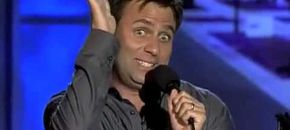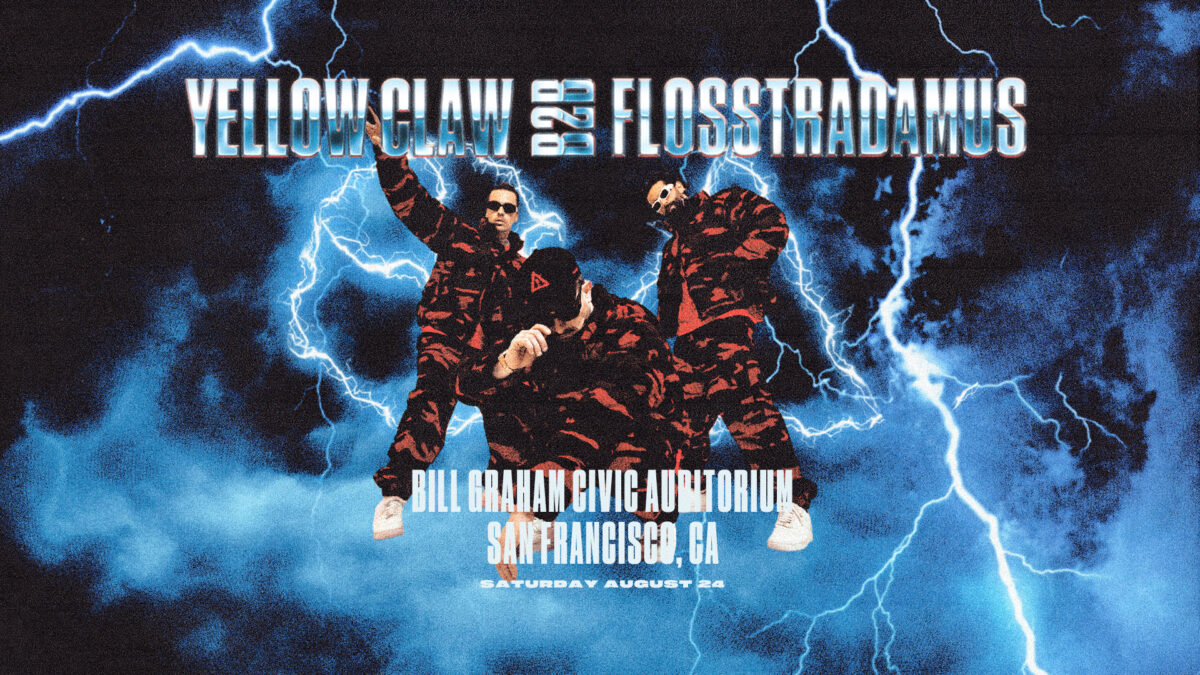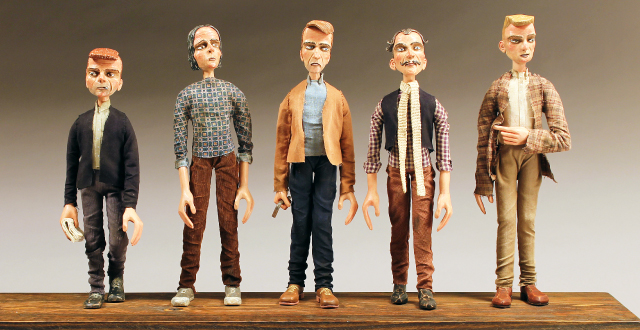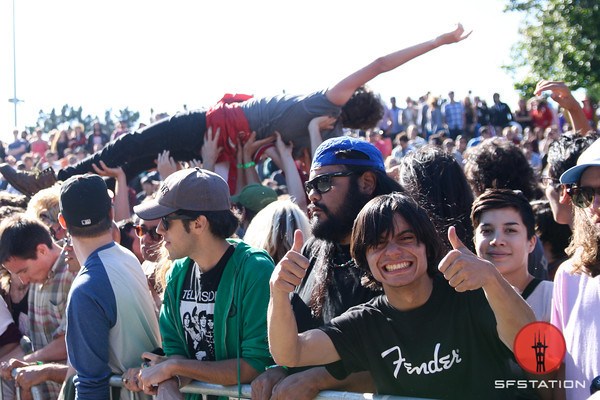Farewell San Francisco, Recently Evicted Local Artist Cunningham on Retrospective Art Show and Leaving SF
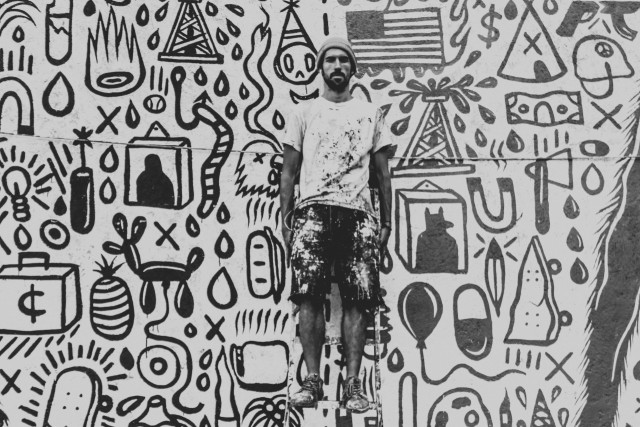
Spencer Keeton Cunningham has had a prolific career as a painter and street muralist for the past decade. For the last two years, he’s been on a self-proclaimed painting tour—holding his belongings together with tape and shoestring in a sack slung over his shoulder while trekking the open road.
He’s been to nearly every continent to debut his work and only recently returned to discover he was being evicted from the SF apartment he’s shared with fellow artists for the past 12 years. This coming Saturday, October 8th, Cunningham’s paintings will be shown in his first-ever solo show, “Farewell San Francisco”, at Heron Arts Gallery from 7-10pm.
Hard, black lines and an essence of simplicity mark much of Cunningham’s work. It can often evolve like a comic book series with a specific narrative unfolding within the work itself—something that reminds Cunningham of what his late friend George Kuchar once said: “movies are like comic books because you have the square and the characters within the square.”
I interviewed the artist to talk about his travels and find out how Cunningham, who’s worked as a painter and filmmaker, as well as with sculpture and music recordings, has leveled his creativity as the medium shifts, and he says, “my hands keep moving in whatever material they touch.”

You work with a lot of different mediums, but they all seem to revolve around similar themes or characters (i.e. melting features, buggy eyes, comic book-looking materials). Do you work with a certain vision in mind or with specific themes in mind?
I guess I have created a few characters with their eyes sticking out of their heads. If this ever appears in my work it’s usually a reference to the animal or character in the painting dealing with the situation they find themselves within (usually being a hostile one). For example, an animal in distress due to being hunted into extinction in Tasmania was the topic of one of my recent paintings. The thylacine [commonly known as the Tasmanian tiger] has its eyes bugged out and lines shooting from its form. Another example would be a painting I made of a couple sharks losing their fin for shark fin soup. It’s also part of how I grew up watching old cartoons like Mighty Mouse when I was a kid. The melting figures in my work are usually a reference to a type of eternal sludge or pollution we place on ourselves and our environments as humans. I recently taught a class on Art as Activism where we focused on shark finning and it was amazing to see the younger generation’s eyes light up when they fully realized their art can create social change for the better.

You recently were forced out of your house after 12 years in SF. Can you explain what happened with your living situation here in SF?
We were dealing with a very dangerous black mold problem—the worst black mold that you can have in a house. I lived in that house for 12 years (on Broderick and Hayes), since I was 20, and I’m 32 now. My friends that I lived with have a child and they’ve suffered many health damages due to the poisoning of the air. It was a problem that the landlord was supposed to remedy in 2014 and in 2016 we did our own toxicity test and found the air within our unit was 100,000 times worse than the air outside. I will miss this place. I didn’t want to leave, although the city has changed quite a bit since I’ve been gone, I was just getting to a point where I was thinking about settling back down in SF after spending 2 years on the road non-stop. The exhibit I’m having is called “Farewell San Francisco”. It’s meant to reference my leaving a city that may not actually be familiar with my art, kind of an ironic “hello” and “farewell” at the same time. The title is also meant to reference the idea of “farewell” to the San Francisco I remember.
What do you like about working with street art versus other mediums?
I enjoy working on large scale murals because it gives the public a chance to become part of the work in a sense. I am constantly influenced while in the process of making a public work, whether its sculpture or a painting on a wall. The people that walk by find a way into the painting I’m creating. I like to make each work in each place specific to the area, whether it’s in Guerrero, Mexico or Juneau, Alaska.

When you draw large-scale murals that include a lot of different elements or objects, do you find they all tie together to tell a story? How do you juxtapose them?
The works evolve as an autobiographical story of my life. Some paintings are a bit esoteric: they are meant to reference certain attempts historically and currently to destroy culture with greed, but there is no stopping the power of people when they gather together for positive change. One example currently would be the Standing Rock Sioux Tribes battle against the Dakota Access Pipeline. The battle against putting an oil pipeline under a peoples’ water supply may not be gracing the popular news outlets at the moment, but it is very real and it’s still happening.
How do you feel the subjects of your art have transformed in design or meaning throughout time?
The subjects transform like shape-shifting, half-human, half-animal, creatures throughout time. I guess you could say my art takes on Darwinian qualities, evolving as I go. I get myself into trouble experimenting in the moment too much at times, but I like pulling from a pool of various styles that I have and creating new ones in the moment because it’s much more fun that way. I think the death of art is when you have created a particular style and you market it as yourself, and you sell it. It becomes defining of your art and that can become your ball and chain, in a sense. I think the best artists let go of being defined by one particular style. Once your art becomes a generic, repeated formula, it’s my opinion that that’s the end of the art. Our current society can be guilty of labeling the “successful artist” as the one that’s turned himself or herself into a commodity by using such tactics.

You’ve been pretty successful at not staying in one place. How has traveling around the world and painting shaped your outlook on what it means to be an artist?
It’s shaped what I create in a huge way and being an artist on the road in the way that I have has created a lot of room to grow. I grew up on the road and now being on the road for 2 years straight feels like a re-connection with my childhood, I guess. I remember being up in the Yukon in the middle of the winter painting and thought to myself—in the total silence of the snow-covered, natural environment up there—“this is it, this is the moment that I’m going to remember when I’m an old man”. I’m very affected by every culture I come in touch with and I’m usually most interested in the indigenous communities of each area I paint in—whether it’s the Yucatan or just the landscape of Native American reservations throughout the United States.
Some of the proceeds for the show are going to the Standing Rock Sioux Tribe. Can you talk a little about your connection to the Native American identity?
As far as my own identity: I grew up hunting and fishing on my Indian Reservation as a young child. Some of the themes in my work come directly from my experience on my reservation and the ideas of contemporary Indigenous identity. I am 1/4th Colville and I’m a recognized member of my tribe. My grandmother was full-blooded and my father was half. There were times in my early childhood where we lived in a blue van next to a lake on the Rez. When I was in SF I was lucky enough to meet up with an amazing group of like- minded Native artists at the college I attended [The San Francisco Art Institute] and there we all gathered together and influenced each others’ art and founded the Indigenous Arts Coalition, a contemporary Indigenous arts organization based in San Francisco with the goal of pushing contemporary Native artwork today. That was a big part of the development of my art.
What will your plans be after the retrospective at Heron Arts?
I will be on the open road; the same place I’ve been for a while. I plan on releasing some of my writings fairly soon and continuing to paint.
Editor’s Note: You can find a link to Cunningham’s writing here.


